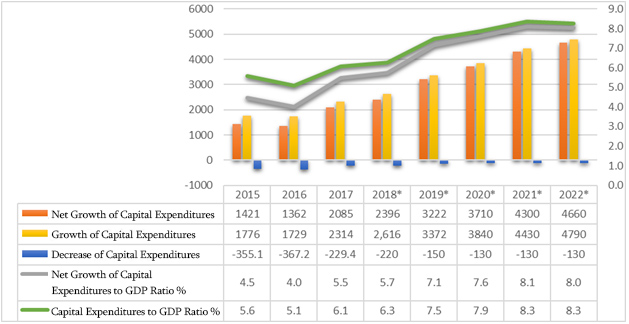Resume: Capital expenditures include all budget expenses which are allocated for funding of investment and innovation programmes as well as all other expenses aimed to increase capital. For instance, capital expenditures include: the purchase of goods to create state reserves, the purchase of fixed capital, the purchase of machinery, equipment, transport and other means; the purchase of buildings and premises, etc.
The planned data of Georgia’s budget is given in the Country Basic Data and Directions for 2019-2022 document. In accordance with the data given in the document, there are plans to increase non-financial assets (capital expenditures) by nearly GEL 24.9 billion in total. The net growth of capital expenditures[1] constitutes approximately GEL 23.1 billion. The capital assets to GDP average ratio in 2019-2022 will be nearly 8%. Therefore, the statement of the Minister of Finance is true.
Analysis
On 13 November 2018, at the plenary session of the Parliament of Georgia, the Minister of Finance of Georgia, Ivane Machavariani, stated: “In 2017-2022, the capital expenditures to GDP ratio will be 8% on average which is more than the GEL 25 billion value project.”
Whilst discussing the draft budget, the issue of the allocation of budget funds between current expenses and capital expenditures is important.
Current expenses comprise an account of the planned operations of government organisations and include: expenses to purchase goods and services, payment of interest rates, subsidies, subventions[2] and current transfers.
Capital expenditures include all budget expenses allocated for the funding of investment and innovation programmes as well as any other expenses aimed to increase capital. For instance, capital expenditures include the purchase of goods to create state reserves, the purchase of fixed capital, the purchase of machinery, equipment, transport and other basic means; the purchase of buildings and premises, construction and re-construction, capital maintenance of machinery, transport and buildings.
The planned data of Georgia’s budget is given in the Country Basic Data and Directions for 2019-2022 document.
Graph 1: Planned Dynamic of Capital Expenditures
Source: Ministry of Finance of Georgia
In accordance with the data given in the document, there are plans to increase non-financial assets (capital expenditures) by nearly GEL 24.9 billion in total. The net growth of capital expenditures constitutes approximately GEL 23.1 billion. The capital assets to GDP average ratio in 2019-2022 will be nearly 8%. Therefore, the statement of the Minister of Finance is true.
[1] Net growth – the difference between the increase in non-financial assets and the decrease in non-financial assets.
[2] Monetary aid allocated for certain events which is subject to return in the case of the violation of subvention purpose or respective dates.









